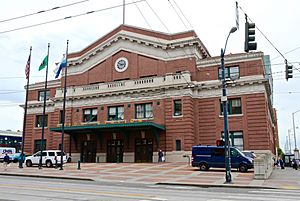Sound Transit facts for kids
 Union Station, Sound Transit's headquarters since 1999 |
|
| Agency overview | |
|---|---|
| Formed | September 17, 1993 |
| Type | Regional transit authority |
| Jurisdiction | Seattle metropolitan area |
| Headquarters | Union Station 401 S. Jackson Street Seattle, Washington 47°35′55.32″N 122°19′42.6″W / 47.5987000°N 122.328500°W |
| Motto | "Ride the Wave" |
| Employees | 802 |
| Annual budget | $1.6 billion USD (2017) |
| Agency executive |
|
| Key document |
|
Sound Transit (ST) is a public transportation system in the Seattle area of Washington, United States. It helps people travel around Seattle and nearby cities. Sound Transit uses different types of transportation to do this.
You can ride Sound Transit using light rail trains, commuter trains, and buses. This system helps thousands of people get to school, work, and other places every day. Sound Transit gets its money from different taxes. These include sales tax, property tax, and a fee on car license plate stickers, also called "car tabs."
Contents
What is Sound Transit?
Sound Transit is a special organization that manages public transportation. It is officially called the Central Puget Sound Regional Transit Authority. It was started on September 17, 1993. Its main office is at Union Station in Seattle.
How Sound Transit Helps People Travel
Sound Transit provides several ways for people to get around.
- Light Rail: These are electric trains that run on tracks. They often travel above or below the ground. They are great for fast trips between cities.
- Commuter Trains: These trains carry people from their homes in one city to their jobs in another. They are helpful for longer daily trips.
- Buses: Sound Transit also operates many bus routes. Buses connect neighborhoods and cities, making it easy to reach many places.
Who Pays for Sound Transit?
Sound Transit needs a lot of money to run its trains and buses. This money comes from people who live in the area.
- Sales Tax: This is a small extra charge you pay when you buy things.
- Property Tax: This is a tax paid by people who own land or buildings.
- Car Tabs: This is a fee you pay each year when you renew your car's license plate sticker.
These taxes and fees help pay for new trains, buses, tracks, and stations. They also cover the costs of running the system every day.
See also
 In Spanish: Sound Transit para niños
In Spanish: Sound Transit para niños

